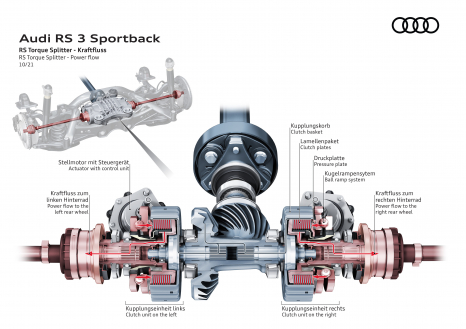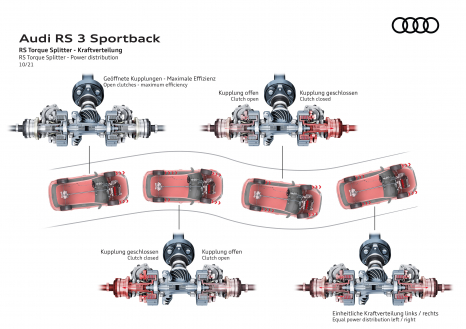Audi RS 3 - RS Torque Splitter
The Audi RS 3 represents the epitome of unadulterated driving dynamics. This is Audi’s first vehicle to feature the RS Torque Splitter, which distributes drive torque between the rear wheels in a fully variable manner. This results in optimal stability and maximum agility – especially when cornering at high speeds.
How does the RS Torque Splitter work?
The RS Torque Splitter makes active, fully variable torque vectoring between the rear wheels possible. Unlike the rear axle differential and the previous multiple disc clutch package on the rear axle, the torque splitter uses one electronically controlled multiple disc clutch each on the respective drive shaft. During dynamic driving, the torque splitter increases the drive torque to the outer rear wheel with the higher wheel load, which significantly reduces the tendency to understeer. In left-hand curves, it transmits the torque to the right rear wheel, in right-hand curves to the left rear wheel, and when driving straight ahead to both wheels. This results in optimal stability and maximum agility – especially when cornering at high speeds. When driving on closed roads, the torque splitter enables controlled drifts by applying all of the engine power at the rear axle to just one of the rear wheels – up to a maximum of 1,750 newton meters of torque. The exact distribution of drive torque always depends on the mode selected in Audi drive select and the respective driving situation.
Each of the two multiple disc clutches has its own control unit, which use the electronic stabilization control’s wheel speed sensors to measure the wheel speeds. Other influencing factors include longitudinal and lateral acceleration, the steering angle, the position of the gas pedal, the selected gear, and the yaw angle, i.e. the rotational movement around the vertical axis. In addition, the torque splitter is connected to the modular vehicle dynamics controller as a higher-level entity.
Why does the torque splitter improve driving performance?
06/21
Due to the difference in propulsive forces, the car turns into the curve even better and follows the steering angle more precisely. This results in less understeer, earlier and faster acceleration when exiting corners, and particularly precise and agile handling – for added safety in everyday use and faster lap times on the racetrack. The torque splitter also compensates for oversteer by directing the torque to the wheel on the inside of the curve or, if necessary, to both wheels.

